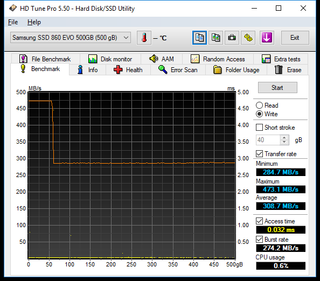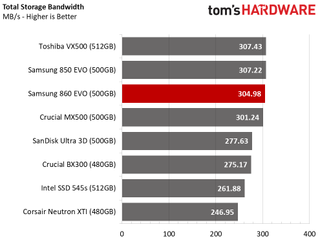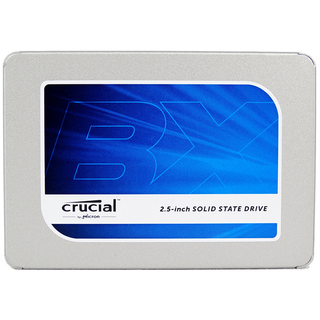The 860 EVO Review: Samsung Back On Top
The world's best selling SSD just got a makeover.
Why you can trust Tom's Hardware
Comparison Products
We have three new 512GB-class drives that we haven't presented data for yet. The first is our Samsung 860 EVO. We also have the Crucial MX500 and SanDisk Ultra 3D, which are the EVO's two closest competitors. The Ultra 3D should give us the same results as the Western Digital Blue 3D 500GB. Both products use the same firmware, flash, and controller.
We also have Intel's SSD 545s, which is the first consumer SSD with 64-layer NAND. It joins the Crucial BX300, 850 EVO, Corsair Neutron XTI, and Toshiba VX500.
All of these SSDs use sixteen 256Gbit (32GB) die to provide 512GB of capacity. This is enough to keep the basic workload performance near the limits of SATA, but we should see more variation in this capacity class than we observed with the 1TB drives.
Sequential Read Performance
To read about our storage tests in-depth, please check out How We Test HDDs And SSDs. We cover four-corner testing on page six of our How We Test guide.


There is very little difference in burst performance between modern drives during a simple sequential read test. All of the drives deliver more than 530 MB/s at QD2. The Corsair Neutron XTI leads with nearly 560 MB/s at QD2, and that's right where the drives all reach the limit of the SATA interface.
Sequential Write Performance


As we mentioned above, there is more potential for variation as we move to smaller capacities. Compared to the 1TB SSDs, we see that more 512GB-class drives are incapable of delivering over 500 MB/s of write throughput at QD2. The 860 EVO is not among that group. Instead, it matches the Corsair Neutron XTI with the highest sequential write speed at QD2.
Sustained Sequential Write Performance

Samsung cut the number of NAND die in half in this model. That hurts the 860 EVO's performance significantly when the workload saturates the TurboWrite cache and falls into the TLC NAND. Performance drops to 285 MB/s. Samsung provides roughly 50GB of SLC cache, which is enough to write a full Blu-Ray ISO file without experiencing reduced TLC NAND performance.
Random Read Performance



Samsung led the random read test at low queue depths for several years, largely because it was the only company with 3D NAND. That's no longer the case in the 64-layer NAND era. Intel, Micron, Toshiba, and SanDisk/Western Digital have closed the massive gap during the last two 3D NAND product cycles.
The 860 EVO still delivers impressive random read performance at low queue depths, but it doesn't lead the pack.
Random Write Performance



The new 860 EVO does take the top spot in random write performance at low queue depths. Random write performance exploded with the introduction of SLC cache, so all of the products deliver very high performance.
70% Mixed Sequential Workload
We describe our mixed workload testing in detail here and describe our steady state tests here.


We found the new 860 EVO and Toshiba VX500 at the top of the QD2 mixed workload test. Many of the products using 3D flash surpass 400 MB/s. The SanDisk Ultra 3D falls to the bottom of the list with just 304 MB/s.
70% Mixed Random Workload


The MX500 leads the QD2 mixed random workload while the 500GB 860 EVO falls to the middle of the pack. The new EVO falls several spots behind the older 850 EVO.
Sequential Steady-State



The 860 EVO's tuning for desktop workloads makes it a great product for mainstream users, but it's not built for extended heavy workloads. For many years we could point to endurance specifications and identify the consumer SSDs that would work well in this environment. TLC changed the industry and created two distinct classes; the SSDs that can write at high rates for an extended period of time, and the SSDs that can only achieve high performance in small bursts. The EVO series with V-NAND fell somewhere in the middle, but Samsung still had the upstream Pro series for prosumer workloads.
Now that other companies have 3D flash they have increased their steady-state performance and reduced the EVO's lead.
Random Steady-State


The 860 EVO is the only consumer SSD at this capacity point that still has a strong and consistent result in this test. The Neutron XTI leads through most of the test due to its larger spare area, but once it is saturated, the 860 EVO takes the lead. Users will see around a 2,000 IOPS increase over the previous generation 850 EVO.
PCMark 8 Real-World Software Performance
For details on our real-world software performance testing, please click here.










The 860 EVO 500GB looks better than the 1TB model, but that's misleading. All of the SSDs are nearly identical, but the 860 EVO just fares better during the latter stages of this extended series of tests.
Application Storage Bandwidth

The 500GB 860 EVO gives us a combined throughput result of nearly 305 MB/s, which is the same as the 1TB model. The MX500 is still right on the 860 EVO's heels, but the former costs significantly less.
PCMark 8 Advanced Workload Performance
To learn how we test advanced workload performance, please click here.



The 860 EVO leads during the recovery phases, which have five-minute breaks to allow the SSDs to recover during idle time. The SanDisk Ultra 3D matches the older 850 EVO, but the other products are not far behind. Samsung's new EVO breaks away from the pack and is back on top of the consumer SSD market.
Total Service Time



The service time test closely relates to the user experience. This is how long it takes the drive to complete the tasks, and not how fast the drive moves the data. The 860 EVO provides the best user experience in these common daily applications, but it's also joined by the SanDisk Ultra 3D, 850 EVO, and Corsair Neutron XTI.
Disk Busy Time

The 860 EVO works harder during heavy workloads than some of the other drives. The disk busy time tests show us how long the drives work to complete the assigned tasks. This can vary from the two previous tests and has an impact on power consumption. The drive stays in an active power state for a longer period if it can't complete the workload quickly.
BAPCo SYSmark 2014 SE Responsiveness Test


The 850 EVO is one of the most responsive SSDs ever released. We've had nothing but praise for it since the release several years ago. The 860 EVO doesn't provide the same responsiveness during light office workloads.
BAPCo MobileMark 2012.5 Notebook Battery Life
To learn how we test advanced workload performance, please click here.


Again, we see issues with the 860 EVO and notebook battery life. According to the power specifications, this series should perform very well and provide extended battery life, but that isn't the case. We suspect Samsung will address this issue at some point with a firmware update. We'll follow up with retesting afterward.
MORE: Best SSDs
MORE: How We Test HDDs And SSDs
MORE: All SSD Content
Current page: 512GB Class Performance
Prev Page 1TB Class Performance Next Page 256GB Class PerformanceStay on the Cutting Edge
Join the experts who read Tom's Hardware for the inside track on enthusiast PC tech news — and have for over 25 years. We'll send breaking news and in-depth reviews of CPUs, GPUs, AI, maker hardware and more straight to your inbox.
-
logainofhades I think I would rather have the better Price/GB of an MX300. MX300 has more storage and is cheaper. The 960 evo isn't much more either really, at the 250gb level anyway.Reply
PCPartPicker part list / Price breakdown by merchant
Storage: Samsung - 960 EVO 250GB M.2-2280 Solid State Drive ($118.99 @ SuperBiiz)
Storage: Samsung - 860 Evo 250GB M.2-2280 Solid State Drive ($94.99 @ Amazon)
Storage: Crucial - MX300 275GB M.2-2280 Solid State Drive ($89.89 @ OutletPC)
Total: $303.87
Prices include shipping, taxes, and discounts when availableGenerated by PCPartPicker 2018-02-08 16:21 EST-0500 -
AlistairAB So basically the MX500 is cheaper and even has better random read performance (the only metric i really pay attention to).Reply
Also Samsung doesn't provide warranty service in Canada properly, a caution to readers. (Search for horror stories about the 960 EVO warranty process in Canada at redflagdeals if you want more... basically they stonewall you requiring you to return to retailers, which is how it works in Europe, not in Canada).
Buy Crucial. -
Dark Lord of Tech Sticking with my Samsung 960 EVO Series 1TB too , crazy fast , but the 860 is another solid release from Samsung , best on the market in terms of reliability.Reply -
Martell1977 So it seems that this is a 850 EVO but with higher bandwidth and warranty. I'm glad to see that my 850 EVO 500gb is still one of the best. Seems that performance for these drives has been stagnate for a while now.Reply -
Radar_1 If I decide to head to the store and purchase a new SSD, the 850 EVO appears to still be the best bang for your dollar.Reply -
JonDol "The 860 EVO has half the endurance of the new 860 Pro, but it's still quite a bit more than competing products. It's a good argument, but who really cares?" Well, I do. For that reason I only buy the Pro ones and I'd buy the EVOs above all the others if the Pro weren't available.Reply
About the title: I wasn't even aware that Samsung had lost the leading spot :-)



